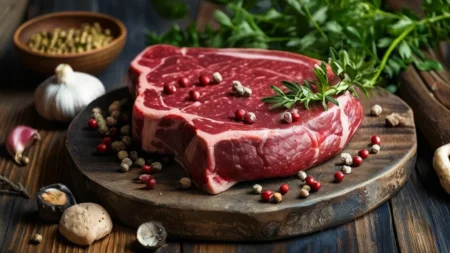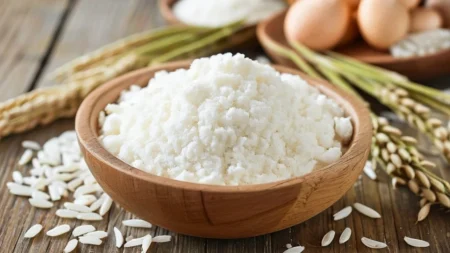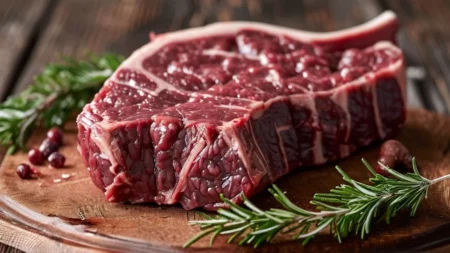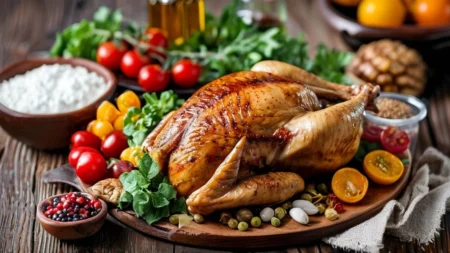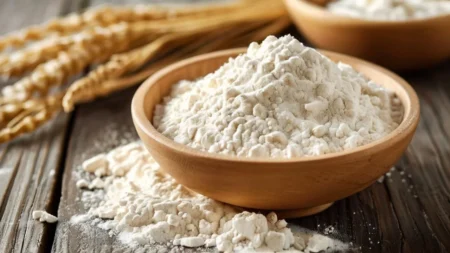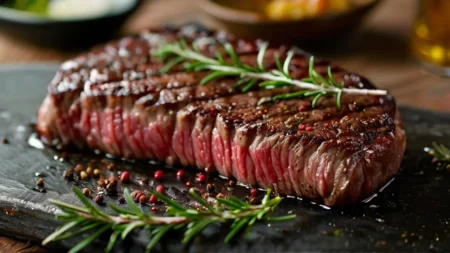Veal: A Tender, Nutrient-Dense Meat Choice
Key Takeaways
- Veal is a high-protein, low-fat meat known for its tender texture and mild flavor.
- Rich in essential nutrients like vitamins B12, niacin, zinc, and iron, veal supports energy production, immune health, and muscle growth.
- Veal is lower in fat compared to beef and provides significant amounts of high-quality protein, making it an excellent addition to a balanced diet.
- Veal can be used in a variety of dishes, from roasts and stews to cutlets and ground meat.
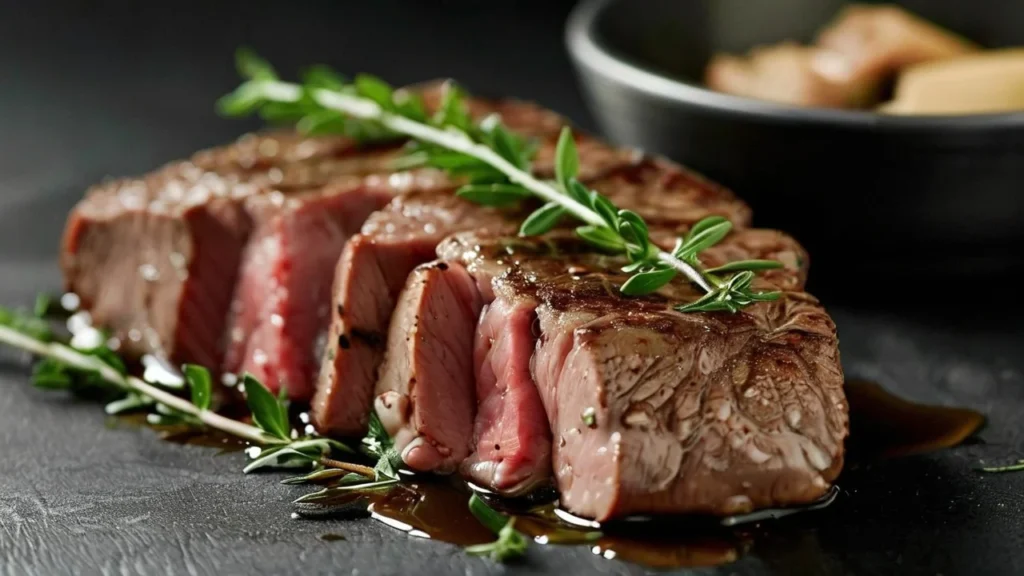
What is Veal?
Veal is the meat from young calves, typically under 12 months old, and is prized for its delicate flavor and tenderness. It has been consumed in various cultures for centuries and is often considered a luxury meat due to its soft texture. The meat is pale pink to light red, depending on the age of the calf and how it was fed.
Veal is typically produced in two main types:
- Milk-Fed Veal: Calves that are fed a milk-based diet, producing meat with a pale pink color and mild flavor.
- Grain-Fed Veal: Calves fed a combination of grains and milk, resulting in a slightly darker color and richer taste.
Nutritional Value of Veal
Veal is a nutrient-dense meat, providing high levels of essential vitamins and minerals, particularly B vitamins, zinc, and iron, all of which are vital for maintaining energy levels, supporting the immune system, and promoting muscle function.
Table 1: Nutritional Profile of Veal (per 100g, cooked)
| Nutrient | Amount | % Daily Value (DV) |
|---|---|---|
| Calories | 172 | – |
| Protein | 24.4 g | 49% |
| Total Fat | 7 g | 11% |
| Saturated Fat | 2.4 g | 12% |
| Cholesterol | 98 mg | 33% |
| Vitamin B12 | 1.8 mcg | 75% |
| Niacin (B3) | 6.3 mg | 32% |
| Zinc | 4.2 mg | 28% |
| Iron | 1.2 mg | 15% |
Health Benefits of Veal
High-Quality Protein Source
Veal is an excellent source of high-quality protein, essential for muscle growth, tissue repair, and overall body function. With over 24 grams of protein per 100 grams, it supports muscle maintenance and development, making it ideal for individuals with active lifestyles or those looking to increase their protein intake.
- Scientific Insight: Research in the Journal of Nutrition highlights that lean meats like veal contribute significantly to muscle protein synthesis, particularly when combined with resistance training.
Supports Energy Metabolism
Veal is rich in B vitamins, especially niacin (B3) and vitamin B12. These vitamins are essential for converting food into energy and supporting brain and nervous system health. A diet rich in these nutrients can help prevent fatigue and support overall vitality.
Rich in Zinc and Iron for Immune Health
Zinc and iron are critical for maintaining a healthy immune system. Zinc plays a role in cell growth, wound healing, and immune defense, while iron is essential for oxygen transport throughout the body. Consuming veal regularly can help prevent iron-deficiency anemia and promote strong immune function.
Types of Veal Cuts and Their Uses
Veal is a versatile meat that can be prepared in numerous ways. The meat is generally leaner and more tender than beef, making it suitable for a variety of culinary techniques.
List: Popular Veal Cuts
- Veal Cutlets: Thin slices from the leg, commonly used for dishes like Wiener Schnitzel.
- Veal Shanks: From the lower leg, perfect for slow-cooked dishes like Osso Buco.
- Veal Loin: A tender cut from the back, ideal for roasting or grilling.
- Veal Shoulder: A tougher cut best suited for braising or slow roasting.
- Ground Veal: Used in meatballs, burgers, and sauces for a leaner alternative to ground beef.
Veal vs. Beef: Nutritional and Culinary Comparison
Though veal comes from young calves and beef from older cattle, the two meats differ significantly in texture, flavor, and nutritional composition.
- Veal: More tender, leaner, and milder in flavor. It contains less fat than beef and is often used in more delicate dishes.
- Beef: Typically more robust in flavor, with a higher fat content. Beef cuts are generally tougher than veal, making them better suited for grilling and barbecuing.
Table 2: Veal vs. Beef Nutritional Comparison (per 100g, cooked)
| Meat Type | Calories | Protein | Fat | Saturated Fat | Iron |
|---|---|---|---|---|---|
| Veal | 172 | 24.4 g | 7 g | 2.4 g | 1.2 mg |
| Beef | 250 | 26 g | 17 g | 7 g | 2.7 mg |
Culinary Techniques for Cooking Veal
Veal can be prepared using a variety of cooking methods, each bringing out its delicate flavor and tender texture. It pairs well with herbs, spices, and lighter sauces, allowing the meat’s subtle taste to shine through.
List: Common Cooking Methods for Veal
- Pan-Frying: Ideal for veal cutlets, often breaded and fried until golden.
- Roasting: Best for larger cuts like veal loin, seasoned with herbs and cooked to tender perfection.
- Braising: Perfect for tougher cuts like veal shoulder, which benefit from slow cooking in broth or wine.
- Grilling: Veal chops can be grilled, adding a smoky flavor without overpowering the meat’s natural taste.
- Slow Cooking: Veal shanks are often slow-cooked to break down the collagen, resulting in a melt-in-your-mouth texture.
Veal and Dietary Considerations
Weight Management
Veal is lower in fat compared to many other meats, making it a suitable choice for individuals on a weight management plan. Its high protein content helps promote satiety, reducing hunger and aiding in portion control.
Paleo and Keto Diets
Due to its high protein and low carbohydrate content, veal is an excellent option for those following Paleo or Keto diets. Its versatility also allows for incorporation into various low-carb meals, from grilled veal chops to veal-based stews.
Rich in Nutrients for Growth and Development
The combination of iron, zinc, and B vitamins in veal makes it particularly beneficial for children and teenagers, supporting healthy growth and development. These nutrients are crucial for energy production, immune support, and cognitive function.
Veal Farming and Sustainability
Veal farming has evolved in recent years, with an increased focus on animal welfare and sustainable practices. Many veal producers have shifted toward more humane farming methods, including group housing systems where calves have room to move freely, which improves their overall well-being.
Ethical Farming Practices
- Group Housing: Many farms now raise calves in group environments, providing space to interact and move, promoting better animal welfare.
- Free-Range and Organic Options: Some veal farms offer free-range and organic options, ensuring calves are raised without antibiotics and growth hormones. These practices not only produce higher-quality meat but also align with the values of health-conscious consumers.
Conclusion
Veal is a tender, nutrient-dense meat that offers high-quality protein, essential vitamins, and minerals while being lower in fat than beef. Its versatility in the kitchen makes it a great choice for a variety of dishes, from delicate cutlets to hearty stews. Incorporating veal into your diet can provide numerous health benefits, including supporting muscle growth, energy metabolism, and immune function. With the rise of sustainable and humane farming practices, veal has become a more ethical choice for those looking to enjoy this luxurious meat.
FAQ
1. Is veal healthier than beef?
Veal is generally leaner and lower in fat compared to beef. It is also more tender, making it easier to digest. However, both meats are excellent sources of protein and nutrients, and the choice depends on personal preference and dietary goals.
2. What is the best way to cook veal?
Veal is versatile and can be cooked using various methods. For tender cuts like veal loin, roasting or grilling is recommended. Tougher cuts, like the shoulder, benefit from slow cooking methods such as braising.
3. Can I substitute veal for beef in recipes?
Yes, veal can be substituted for beef in most recipes. Keep in mind that veal is leaner and more delicate, so it may require shorter cooking times or gentler methods to prevent overcooking.
4. Is veal environmentally sustainable?
Sustainability practices in veal farming are improving, with many farms adopting ethical farming practices like group housing and organic options. These methods reduce the environmental impact and promote animal welfare.
5. Is veal a good source of iron?
Yes, veal is a good source of iron, though it contains slightly less iron than beef. Iron is essential for producing hemoglobin and maintaining energy levels,





